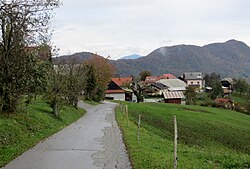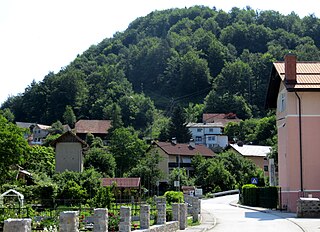
Jevnica is a settlement on the right bank of the Sava River in the Municipality of Litija in central Slovenia. The railway line from Ljubljana to Zidani Most runs through the settlement. Traditionally the area was part of Lower Carniola and is now included with the rest of the municipality in the Central Sava Statistical Region; until January 2014 the municipality was part of the Central Slovenia Statistical Region.

Gabrovka is a settlement in the Municipality of Litija in central Slovenia. Traditionally the area was part of the Lower Carniola region. It is now included with the rest of the municipality in the Central Sava Statistical Region; until January 2014 the municipality was part of the Central Slovenia Statistical Region. In addition to the center of the settlement, formerly known as Sveti Križ pri Litiji, it includes the hamlets of Orešje, Pretržje, and Trzne.

Gabrska Gora is a settlement south of Gabrovka in the Municipality of Litija in central Slovenia. Traditionally the area was part of Lower Carniola and is now included with the rest of the municipality in the Central Sava Statistical Region; until January 2014 the municipality was part of the Central Slovenia Statistical Region. It includes the hamlets of Gora, Stari Boršt, Gabrje, and Turn.

Klenik is a settlement east of Vače in the Municipality of Litija in central Slovenia. Traditionally the area was part of Lower Styria and is now included with the rest of the municipality in the Central Sava Statistical Region; until January 2014 the municipality was part of the Central Slovenia Statistical Region.

Okrog is a small settlement south of Gabrovka in the Municipality of Litija in central Slovenia. Traditionally the area was part of Lower Carniola and is now included with the rest of the municipality in the Central Sava Statistical Region. The settlement is known as Ukrog in the local dialect. It includes the hamlet of Dule.

Podšentjur is a settlement on the right bank of the Sava River in the Municipality of Litija in central Slovenia. Traditionally the area was part of Lower Carniola and is now included with the rest of the municipality in the Central Sava Statistical Region.
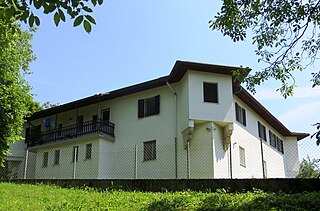
Pogonik is a settlement on the right bank of the Sava River north of Litija in central Slovenia. The railway line from Ljubljana to Zidani Most runs through the settlement. Traditionally the area was part of Lower Carniola and is now included with the rest of the Municipality of Litija in the Central Sava Statistical Region.

Polšnik is a settlement in the Municipality of Litija in central Slovenia. Traditionally the area was part of Lower Carniola and is now included with the rest of the municipality in the Central Sava Statistical Region. Together with the two parts of the main settlement it also includes the hamlets of Na Puši, Seruč, Koprivnik, Slop, Glinjek, Velika Njiva, and Sušje.

Ponoviče is a settlement along the left bank of the Sava River in the Municipality of Litija in central Slovenia. The railway line from Ljubljana to Zidani Most runs through the settlement. Traditionally the area was part of Styria and is now included with the rest of the municipality in the Central Sava Statistical Region. The settlement includes the hamlets of Mačkovina and Smrekarica.

Ribče is a settlement on the left bank of the Sava River, opposite Kresnice, in the Municipality of Litija in central Slovenia. The area is part of the traditional region of Lower Styria and is now included with the rest of the municipality in the Central Sava Statistical Region. It includes the hamlets of Spodnje Ribče, Zgornje Ribče, Podreber, and Dašnik.

Tenetiše is a settlement on the right bank of the Sava River east of Litija in central Slovenia. Traditionally the area was part of Lower Carniola and is now included with the rest of the Municipality of Litija in the Central Sava Statistical Region.

Tepe is a settlement in the Municipality of Litija in central Slovenia. Traditionally the area was part of Lower Carniola and is now included with the rest of the municipality in the Central Sava Statistical Region. It includes the hamlets of Zgornje Tepe, Srednje Tepe, Spodnje Tepe, Žamboh, Kleviše, Graben, and Pasjek. The hamlet of Nova Gora is also mentioned in some sources.

Tlaka is a settlement south of Gabrovka in the Municipality of Litija in central Slovenia. Traditionally the area was part of Lower Carniola and is now included with the rest of the municipality in the Central Sava Statistical Region.

Vodice pri Gabrovki is a settlement north of Gabrovka in the Municipality of Litija in central Slovenia. Traditionally the area was part of Lower Carniola and is now included with the rest of the municipality in the Central Sava Statistical Region. The settlement includes the hamlets of Zgornje Vodice, Spodnje Vodice, and Greben.

Vovše is a settlement in the hills east of Vače in the Municipality of Litija in central Slovenia. Traditionally the area was part of Styria and is now included with the rest of the municipality in the Central Sava Statistical Region. It includes the hamlets of Cvetež, Toge, and V Mejah.

Zgornja Jevnica is a dispersed settlement in the hills above Jevnica in the Municipality of Litija in central Slovenia. Traditionally the area was part of Lower Carniola and is now included with the rest of the municipality in the Central Sava Statistical Region. The settlement includes the hamlets of Mala Noga and Mala Dolga Noga.
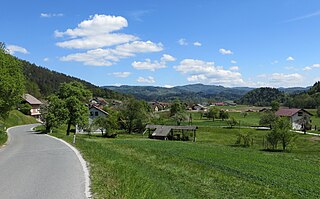
Zavrstnik is a settlement in the Municipality of Šmartno pri Litiji in central Slovenia. It lies in a small valley east of the town of Šmartno pri Litiji in the historical region of Lower Carniola. The municipality is now included in the Central Slovenia Statistical Region.

Gradec is a former settlement in the Municipality of Litija in central Slovenia. It is now part of the town of Litija. Traditionally the area was part of Styria and is now included with the rest of the municipality in the Central Sava Statistical Region.
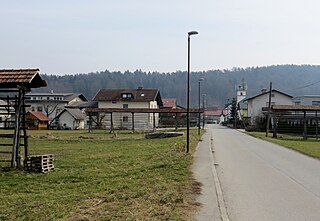
Nadgorica is a formerly independent settlement in the northern part of the capital Ljubljana in central Slovenia. It was part of the traditional region of Upper Carniola and is now included with the rest of the municipality in the Central Slovenia Statistical Region.
